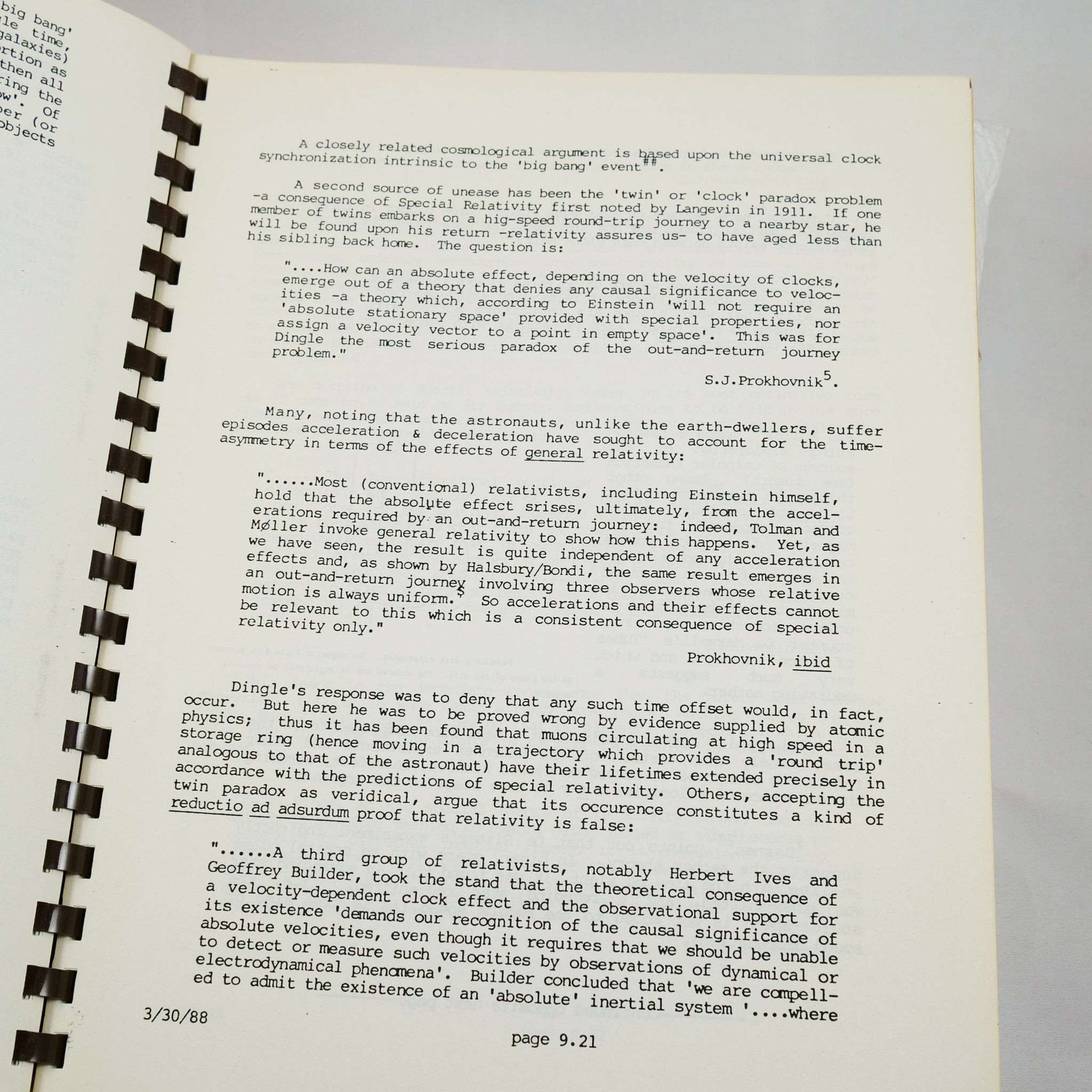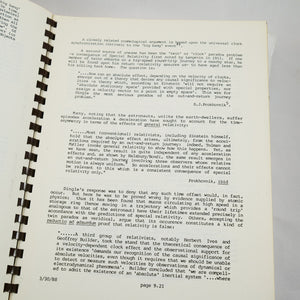Harrison, Stephen | Emanational Physics. A New Theoretical Prolegomenon
£650.00
-
The “second edition” of this rare and unusual self-published text proposing to correct the entire field of modern physics by reframing it metaphysically. Described as a “not-for-sale” edition “limited to 100 copies”, this copy was sent to Allan R. Sandage, the astronomer who determined the first reasonably accurate values for the Hubble Constant and the age of the universe and was considered “the greatest and most influential observational astronomer of the last half-century” (NY Times obituary, November 17, 2010). Sandage’s name appears twice on the recipients list in the front matter (once as no. 2 on the list, and then misspelled on a taped and glued-on addition) and an introductory letter from the author to Sandage, dated 1993, is loosely inserted.
We have been unable to locate much information on the author, Stephen Harrison. The biography on the verso of the dedication leaf describes him as “a science graduate of London University” and “now an American citizen” who is “currently an independent consultant in the ‘High Technology’ field in the Washington D. C. area”. His business card describes him as the “principal scientist” for Directed Technologies, Inc. of Bethesda Maryland, of which we can find no record. The printed address on the card is for a suburban house, and it has been crossed out and corrected with another address for an apartment complex about a mile away. Surprisingly, Harrison has a Linkedin profile, though it is empty except for his title, “independent computer software professional, Bethesda Maryland” and his education history: “London University 1938-1948”. There is no “London University” (at least not since 1836), and it is unclear whether this is entirely fictitious, or if he meant one of the real institutions with a similar name. And while the dates seem questionable, as they put him in his late 80s when Linkedin was founded, an obituary confirming his age appeared in the Washington Post on March 16th, 2016: “Stephen Harrison, philosopher, author of The New Monadology, died peacefully March 12, 2016 at age 96 with his daughters Barbara Harrison and Frances Stroscio by his side”.
In the prefatory matter Harrison also lists three other books he has written: “The Mind/Brain Problem, copyright 1981/1982/1984/1986”, “Artificial Intelligence: A House Built Upon the Sand, 1984”, and “The New Monadology (forthcoming)”. We can locate no institutional copies of Emanational Physics, and only one institutional copy of any of the other books: The New Monadology, at Perdue University, though the copyright date provided in WorldCat is 1981, which would be significantly earlier than indicated by the information here.
This copy seems have been mailed to Sandage a few years after “publication”, as the enclosed letter is dated May 29th, 1993 (as Sandage’s name appears twice in the recipients list, it may have been sent twice). Harrison writes, “I believe you will enjoy some of the chapters of the enclosed, though I fear you must end up dismissing me as a good man gone wrong. One of my complaints with modern cosmology is the way in which they proceed sui generis in the absence of the broader considerations of Mind and Spirituality — which are, so to speak, brought in as afterthoughts, rather than being given equal weight at the outset. Also, the failure to distinguish between Eternity and Endless Time; and between the Potential and the Completed Infinity. Finitude and Temporality, surely, belong in the realm of physical existence, with Infinity and Eternity providing the necessary context beyond.”
The contents of this volume are difficult to describe, but comprise an elaborate, conservative-leaning pseudo-scientific/philosophical critique of modern physics and cosmology, primarily relativity, quantum mechanics, positivism, and materialist understandings of human consciousness. As Harrison writes in the preface, “It is no secret that the state of theoretical physics & cosmology is replete with contradictions and paradoxes. It’s a mess — and, according to such Establishment spokesmen as Richard Feynman, there’s not much we can do about it. Nature is ‘absurd’ and we have no choice but to accept the fact with as good a grace as we are able to muster. I don’t believe it... What’s wrong with physics takes origin, in my view, from what’s wrong with physicists. What is chiefly wrong with physicists is that they are metaphysically light-weight... this handicap of philosophical myopia is canonised into the virtue of emancipation; they believe that the findings and discoveries of physics have somehow pre-empted metaphysics — which may now be discarded as so much useless baggage — and that empiricism has somehow proved itself to be completely self-contained and self-sufficient.”
Not surprisingly, he goes on to explain that, “undaunted by my limited grasp of modern physics, I decided to blunder in, and try my hand at clearing up the mess. What are my credentials? First, I am familiar with the basics and have enough understanding of mathematics to be able to protect myself from the occasional abuses of mathematicians. I have spent much of my life as a consultant in various areas of ‘hard’ science and engineering, and my experience in this occupation has caused me to become monumentally unimpressed by and suspicious of ‘experts’; one thing in which many of them are truly expert in is seeing the trees and missing the woods”.
The text itself is dense and complex, with numerous citations and illustrations, a few of which are coloured in by hand. It begins with an introduction to some of the mysteries and paradoxes of modern physics and a historical outline of “how we got into the present mess”, as well as chapters titled “Ad Hominem: The Intellectual Scrutinized” and “The Decay of Common Sense”. Harrison’s solution to these problems, a system he terms “emanational physics” involves building blocks called “corpuscles” and “reintroducing the Aether” to theory, and it covers the mind, the fabric of the universe, and his conceptualisation of the origin and end of the universe — what he calls the Alpha and Omega.
In the preface, Harrison explains that this second edition has appeared only six months after the first, “chiefly as a result of my very recent discovery of literature sources critical of relativity. At the same time I learned why I had to dig so deep to find this material; it seems it is not easy to publish material contrary to the Establishment Doctrine... In reviewing this material I cannot help but conclude that the case against special relativity is about as solid as can be... I am even tempted to say that it is the most disconfirmed hypothesis since the Phlogiston Theory. Yet it retains its firm occupancy of Stage Center”.
Among the 90 recipients of this text (who must have been thrilled) are mathematician Roger Penrose, AI and information theorist Kenneth M. Sayre, and physicists Murray Gell-Mann, Steven Weinberg, Stephen Hawking, Freeman Dyson, John Archibald Wheeler, James Hartle, and Sheldon Glashow (among many others). A number of non-scientists are also included, such as the conservative political philosopher Paul Gottfried, Scottish Protestant theologian Thomas F. Torrance, Benedictine historian of science Stanley Jaki, and religious philosopher Richard Swinbourne.
Most remarkably, at least a few of them engaged somewhat seriously with Harrison’s text. In the preface he thanks “a number of readers who sent in their comments in response to the original edition — spanning various degrees of agreement and disagreement; several of them brought an important error to my attention (concerning the astronaut round-trip paradox)”. Mathematician Joseph Gerver is specially praised for “his very detailed commentary on a number of points”. And not only did neuroscientist and philosopher Raymond Tallis read Emanational Physics, he cited it in his 1991 book on consciousness, The Explicit Animal. Harrison had used a quotation he attributed to physicist David Bohm, and Tallis includes it in The Explicit Animal, with a footnote reading, “I do not know the original provenance of this passage. It is cited by Stephen Harrison in his remarkable unpublished manuscript Emanational Physics”. The same passage is then used by philosopher Mary Midgley in her book The Ethical Primate, with a footnote referring to Tallis and Harrison: “Tallis says no further details are given. The passage seems, however, to express Bohm’s habitual views and does not in any way appear suspect”.
-
...Second Edition. Bethesda, Maryland: privately published, 1988.
Comb-bound photocopy, text on both the rectos and versos. Title on yellow paper. Original brown paper covers, the upper cover with a plastic window for the title and “BK Dynamics” embossed in gold. The author’s Directed Technologies business card, with the address corrected by hand, is stapled to the upper cover. Illustrations, charts and graphs throughout, one coloured by hand. The author’s name and address in pencil partially erased from the title. Occasional additions and corrections made by taping or pasting in new slips of paper.






